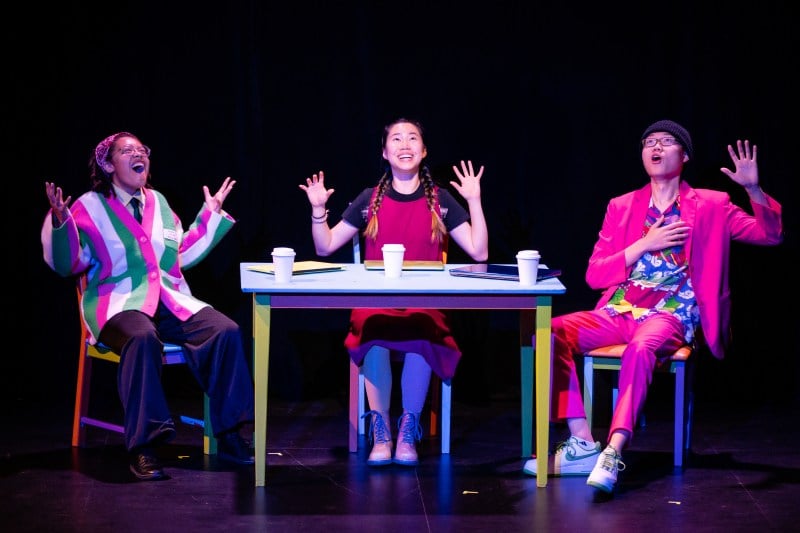“Is the unknown more precious than the known?”
These are the final words of “106,” theater & performance studies (TAPS) senior Sam Howell Petersen’s ’23 capstone project, which was performed in the Nitery Theater Thursday through Saturday. The original play explores how contemporary technology contributes to progress and simultaneous exacerbation of societal issues.
I went into the performance thinking it would consist of mini-plays that poked fun at assignments of the introductory computer science course CS 106A. However, “106” turned out to be a profound and crafted look at the ethics and impacts of technology.
“I was really drawn to the idea of unpacking computer science (CS) in an artistic way, which is something that has precedent but I haven’t seen much at Stanford,” Petersen said, regarding her motivation for creating the play.
The show is a devised work, meaning that it was written, rehearsed and produced during this spring quarter. Rehearsals consisted of not only memorizing lines and scene work, but also writing, editing and workshopping different ideas. First-time actor Peter Li ’25 enjoyed this process of collaboration.
“Being able to create something with some of the most talented people I’ve met has been an incredibly rewarding experience,” Li said.
The production included four vignettes, each named after an assignment from CS 106A. The first piece, “Bias Bars,” is about “the encroachment of tech upon our lives, which we rarely think about,” according to actor Sophia Wang ’26.
The three actors, Li, Wang and Aiyana Washington ’24, portrayed a virtual assistant, Purple, as it fulfilled requests from users. While the scene started off with Purple answering simple questions about the weather or time, the dialogue quickly begins to escalate. The artificial intelligence (AI) assistants’ execution of tasks such as facial recognition showed bias in their algorithms and abuse of users’ private information.
As the act progressed, I could feel the audience’s unease. We laughed initially because the dialogues reminded us of what we asked our own virtual assistants on our phones. However, we fell silent as we realized the play portrayed bias reflected our own reality.
I was impressed by the costumes of the AI assistants. Each had personalized garments such as mismatched rain boots and colorful patterned shirts, linked together by the fuschia-purple color scheme, echoing their name “Purple.” The personalized costumes made the assistants seem individualized, and the color scheme added to their artificial feel.
“Bias Bars” was followed by “Babynames,” which explored AI’s role in creative pursuits, a relevant question in the age of the pioneer AI technology ChatGPT. In the snippet, ChatGPT was called upon by three friends to write scripts, one being about an evil child named “ideal future” who represented the future of technology.
Another vignette, “Sand,” discussed the notion of “how time runs differently for everyone,” Wang told me. During this sequence, Wang acted out how technology is taking away people’s “keys” to opportunities such as jobs. This scene showed how technology “is a double-edged sword.” It made me think of ways in which technology can be used to create possibilities rather than just taking them away.
“Sand” had the three actors portraying the different daily routines: that of a programmer for a technology company, a computer science student working part-time at Costco and a girl eating an apple. I thought these performances were particularly amazing. It even included a live musical performance from Li and Washington.
The play was full of hilarious moments, one of which was in the “no cell phone” warning at the start. The TV screen displayed a video of Stanford University’s president Marc Tessier-Lavigne telling audience members to silence their cell phones and enjoy the show. While I initially thought it was a genuine recording of Tessier-Lavigne, I slowly realized that the video was creatively fabricated. This bit elicited uproarious laughter from the audience.
Being about technology itself, “106” demonstrated innovative use of technology. During “Babynames,” the TV screen used the C++ programming language to display the script ChatGPT created. It was surreal to see the code scroll on the screen as we were watching the play live.
“106” took a meaningful look into the impact of technology on human lives, a topic that is most pertinent at Stanford, where as much as 16% of each class graduates with a CS degree. Within 45 minutes, “106” made the audience wonder what they can do to use technology to create a positive future. It truly accomplished Petersen’s goal of “leaving audiences with questions, not answers.”
While 45 minutes may be enough to intrigue the audience, I would have loved to see a longer production that could explore and develop more ideas. One such idea was introduced in the last vignette, “Quilt,” which imagined a world that was a black box but had walls made of gold underneath the black layer. I feel that this world was a metaphor for our society, but the metaphor could have been more fully explained had it been given a little more run time. In addition, I would like to see “Sand” turned into a more fleshed-out argument about the demanding schedule of a programmer.
As a past student of CS 106A and a current student of CS 106B (the next course in the 106 series), this play made me think of the beautiful ability of CS to create despite its challenging nature. “106” felt more meaningful and applicable than any CS ethics lecture I’ve sat through thus far.
Editor’s Note: This article is a review and includes subjective thoughts, opinions and critiques.
